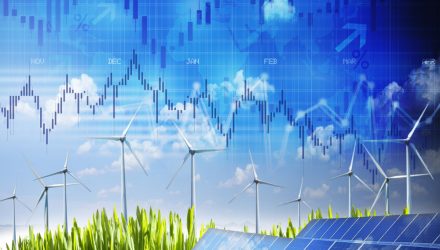Costs associated with global decarbonization efforts and the transition to renewable energy are estimated to be in the tens of trillions of dollars over a multi-decade time horizon.
That’s a staggering amount of capital, and those forecasts, if even remotely close to being accurate, carry implications for exchange traded funds, such as the ALPS Clean Energy ETF (ACES). ACES is a relevant consideration for investors looking to profit from the decarbonization theme because it’s a broad-based ETF with exposure to multiple renewable energy themes.
A diverse approach such as the one offered by ACES could be better equipped to tap into the elevated spending required to accomplish decarbonization goals. That’s something investors should consider because the reality is that capital is flowing to renewable energy projects.
“Capital and investments would start to flow to more sustainable assets and away from less sustainable ones,” notes BlackRock. “We argued that this would cause a repricing over time as we believed markets would get ahead of the actual transition to a greener world. Our new analysis shows the repricing effect is real and growing, as it was negligible in the period 2016-2019.”
The asset manager points to an interesting scenario that could be noteworthy for ACES going forward. Yes, spending on renewable energy is increasing, but it doesn’t exactly match reductions in capital expenditures by fossil fuels producers.
As a result, prices of traditional energy commodities are soaring, making sources of renewable energy, such as solar and wind, more attractive in the process.
“The root cause is that transition of the energy sector has so far been lopsided, we believe, with extra investment in renewables failing to keep pace with reduced capex in fossil fuels,” adds BlackRock. “The higher fossil fuel prices rise, the more competitive renewables become. The outlook for renewables is bright, and we also see lower-carbon fossil fuels playing a key role in ensuring continuity of affordable energy during the transition.”
Ultimately, decarbonization and the green transition will take time and massive amounts of capital. For investors who have the luxury of time, ACES could be a winner as spending in this arena soars.
“We see the transition driving a relative return advantage for greener sectors such as tech and healthcare over browner sectors such as energy for years to come, all else equal. There will be periods when browner assets outperform, and we see investment opportunities in low-cost oil and gas producers leading decarbonization within their sectors,” concludes BlackRock.
Other renewable energy ETFs include the First Trust Global Wind Energy ETF (FAN) and the SPDR Kensho Clean Power ETF (CNRG).
For more news, information, and strategy, visit the ETF Building Blocks Channel.
The opinions and forecasts expressed herein are solely those of Tom Lydon, and may not actually come to pass. Information on this site should not be used or construed as an offer to sell, a solicitation of an offer to buy, or a recommendation for any product.








